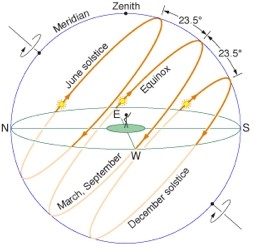Confusion #4: The variable latitude of the Sun’s path
 This is also a problem for anyone who tries to follow the sun in the tropics. The tropics represent the subsolar, or furthest points north or south, of the sun at each solstice. The Tropic of Cancer is the furthest latitude north that the sun appears at the June solstice (June 20th or 21st depending on the year), and the Tropic of Capricorn is the furthest latitude south that the sun appears at the December solstice. These points are respectively 23.5 degrees north and south of the equator. In December this produces snow for Christmas in the northern hemisphere and hot, dry conditions in southern Australia. (Most Aussies spend Christmas at the beach!)
This is also a problem for anyone who tries to follow the sun in the tropics. The tropics represent the subsolar, or furthest points north or south, of the sun at each solstice. The Tropic of Cancer is the furthest latitude north that the sun appears at the June solstice (June 20th or 21st depending on the year), and the Tropic of Capricorn is the furthest latitude south that the sun appears at the December solstice. These points are respectively 23.5 degrees north and south of the equator. In December this produces snow for Christmas in the northern hemisphere and hot, dry conditions in southern Australia. (Most Aussies spend Christmas at the beach!)
The point here is that the Kimberley region of Western Australia is just north of the Tropic of Capricorn, and for part of the year the sun travels in the southern Kimberley sky. If you point the number 12 of a clock at that time of year, thinking you are looking at the sun in the northern sky, you could be starting with a 180 degree error. The Australian advisor for this Bear Grylls episode may not have realised this and where in Australia the advice was being used. The episode was filmed at the start of the wet season in the Kimberley region (December), which would mean an overhead sun in the southern sky.
You can roughly calculate the latitude of the sun’s path for each date. If we start with the June solstice with the sun travelling at 23.5 degrees north, and end with the December solstice, with the sun traveling at 23.5 degrees south, the sun’s path has to change about a degree of latitude every 4 days (6 months is 182 days, the number of degrees to traverse is 47). At the September equinox (22nd or 23rd depending on the year) it will be on the equator (north of the Kimberley) and on, say October 15th, the latitude will be 6 degrees south of the equator.
Confused?
Don’t worry! It only serves to prove the point that followers of the sun can easily get lost by trying to calculate their position using these intricate techniques!
Since these days analogue watches are getting rare, it may be better instead to start your orientation to a new locality by putting a stick into the ground in the daytime and perhaps travel by moonlight in hot locations if safe to do so. Better still, get a GPS device or use the compass on your phone!
Coming Up
If you think following the sun can easily get you lost, for the Easter edition (first full moon after the March equinox), we will explain how followers of the moon can get lost. But before that, contributions about birth date traits from those with access to birth dates in various occupations, apart from the Argentine Army where we started.
May we wish you a Merry Saturnalia and Dies Natalis, and a Happy Perihelion in the meantime (January 2nd)
